The 3-2-1 Column: QBs, defense, hoops transfers, stat-stuffers and more
In this week's 3-2-1 Column, we're thinking about Pitt's QB1, changes to the running game, Jeff Capel's efforts in the transfer portal and a lot more.

THREE THINGS WE KNOW
The obvious option at quarterback
Let’s start this week’s column with the least surprising update of the week…
Okay, it wasn’t necessarily an update or news, because Pat Narduzzi never explicitly said that Phil Jurkovec is Pitt’s No. 1 quarterback.
But he pretty clearly said that Christian Veilleux, Nate Yarnell and Ty Dieffenbach - known collectively as “all the other guys” - are battling for the No. 2 job, and it doesn’t take much deductive reasoning to put 3 and 2 together here.
It equals 5. As in, Jurkovec’s number. And Pitt’s going to call his number this season.
I don’t think any of this is or should be a surprise. From the time Pitt pursued and landed Jurkovec, it was fairly obvious that the intention - on both sides - was for him to be the starting quarterback. Jurkovec came to Pitt to be the starting quarterback and Pitt recruited him to be the starting quarterback.
And he’s going to be the starting quarterback.
Now, that’s not the same thing as saying the job was handed to Jurkovec (even if it looks that way). I am fairly confident that if Veilleux or Yarnell or Dieffenbach or Eli Kosanovich or Jake Frantl or David Lynch - as someone who watched a lot of movies in college, I’m really pulling for Lynch - if any of those guys were to outplay Jurkovec consistently in practice, then they would move ahead of him.
But they haven’t, by all accounts. From everything we’ve heard, he’s been the best quarterback in spring camp through a dozen practices. In fact, he has done well enough on a day-to-day basis that the coaches have limited his work in the scrimmages, opting to get extra reps for Veilleux and Yarnell and Dieffenbach in the interest of seeing who can move the offense best from that group.
But in the group overall, the answer is Jurkovec.
I think the familiarity with Frank Cignetti’s offense is a big factor here. Jurkovec spent two years working with Cignetti at Boston College, and while there have certainly been tweaks to the system, the basics have carried over, and Jurkovec was able to hit the ground running as a result.
It’s not just about knowing the system, though. Jurkovec is a gifted passer, a quarterback with a big arm who can run a little bit and is big enough to shed would-be tacklers here and there. He had success at this level when he was with Cignetti at Boston College a few years ago, and the Pitt coaching staff is betting on him doing it again.
From everything they’ve seen this spring, the coaches seem to be convinced that he can - and will - do it.
So Narduzzi may or may not have slipped when he said that Veilleux, Yarnell and Dieffenbach are battling for the No. 2 job. Ultimately, he told us without telling us that Jurkovec is the top guy, which I think we all mostly assumed already. And it seems like it’s an obvious enough conclusion that Narduzzi isn’t thinking much about the No. 1 job at all; his mind is more focused on who will be No. 2.
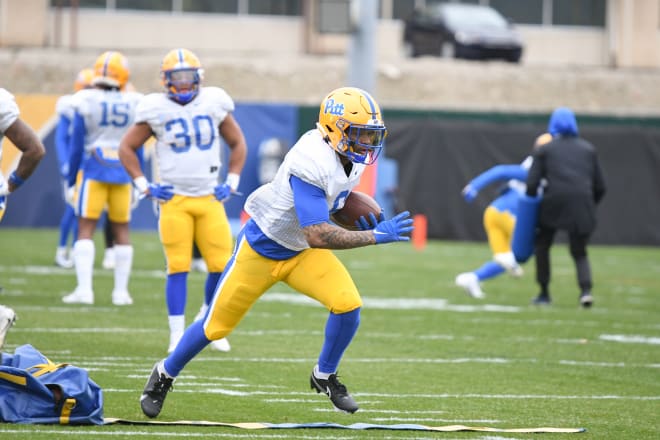
A different kind of rushing success
There’s a long time left until the season starts, but it’s interesting to me how we haven’t really spent too much time ruminating over the transition from Israel Abanikanda to Rodney Hammond in the backfield.
Despite Abanikanda setting a Pitt record, earning All-ACC honors and leading the nation in rushing touchdowns, nobody really seems to be too concerned that he’s gone and Hammond is stepping into his role.
Maybe that’s because Hammond has been pretty good over the last two years. He hasn’t been the primary running back in either season, but when called upon, he has produced. In 20 career games, he has carried the ball 211 times for 964 yards - 4.6 yards per carry - and scored 10 touchdowns. He also has 130 yards and two scores on 14 receptions.
As running backs coach Andre Powell pointed out last week, he’s also got a knack for getting a little more than you expect him to on just about every rushing attempt he makes.
“Here’s the thing about Rodney,” Powell said. “Rodney is a tough dude. Rodney, he’s tough. So Rodney will get the same yards, I think, and more, because he will play more, but Rodney has a knack for, when everybody thinks he’s stopped, he’s not. He’s not stopped. He always finds a way to get two or three more yards when everyone thinks he’s stopped. That’s one of the things that makes him special.”
Last year, Hammond averaged 2.61 yards after contact per attempt, and his career average in that stat is 2.8. Abanikanda averaged 2.67 last year and 2.95 for his career. But a big part of the 644 yards he gained after contact in 2022 came on the big runs.
Against Virginia Tech, when he set a new Pitt record for yards in a single game, Abanikanda picked up more than 100 yards after contact - aided in no small part by his nine runs of 10 yards or more and his seven attempts of 15 yards or more.
All told, Abanikanda had 19 rushes last season that gained at least 15 yards, accounting for a whopping 44.2% of his total rushing yards. He was truly a home-run hitter.
That’s not Hammond’s game.
I don’t mean to say that Hammond can’t break a long run. But he had just three runs of 15 yards or more last season. Obviously he had a mere fraction of Abanikanda’s total attempts, but the yards gained on Hammond’s three runs of 15+ accounted for just 14% of his total yardage.
Hammond ran well in 2022. He averaged more than four yards per carry and lost just five yards on 109 attempts, and when he got his opportunity to start the games against Syracuse and UCLA, he responded with 218 yards and three touchdowns on 53 carries.
He’s a good back. He’s just not Abanikanda. He has different “DNA,” as Powell put it.
Consider those stats I mentioned about the runs of 15 yards or more. Abanikanda picked up a slew of yards on those runs and Hammond didn’t. But if you look at the other rushing attempts - the ones that didn’t get 15 yards or more - the stats start to favor Hammond. On runs of 14 or less, Hammond averaged 3.71 yards per carry; Abanikanda averaged 3.58.
That’s not a huge difference, but it’s a difference.
Hammond might not be the home-run hitter that Abanikanda was, but he can get a little bit more out of his rushing attempts, and that’s not a bad way to go about it. You’d like to be able to strike fast, but if you can’t, then grinding away and pushing a defense down the field can be a pretty effective approach.
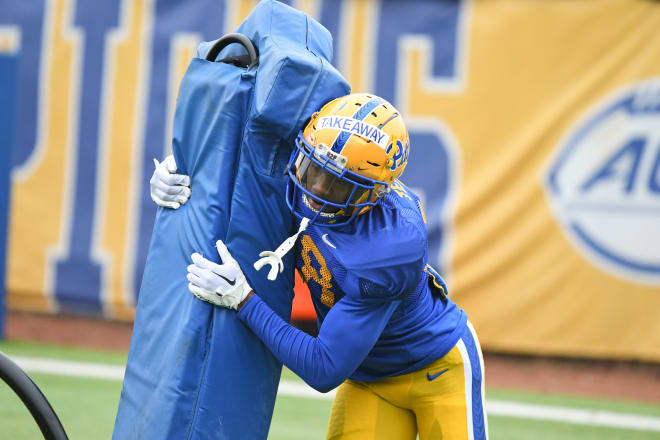
The reload
I think if you consume enough Panther-Lair content in a week, you kind of know where my brain is. Or, at the very least, you know what kinds of things I’ve been thinking about a lot.
Like Pitt’s defense. I’ve been thinking about that a lot this week.
It’s probably because the defense emerged as the winners of last Saturday’s scrimmage, marking back-to-back wins for the defense in spring scrimmages this year. That’s not entirely surprising, since defense often starts faster than offense, or so the old cliche goes.
But it’s a little surprising for other reasons. By name, I would call those reasons Calijah Kancey, SirVocea Dennis, Brandon Hill, Erick Hallett, Habakkuk Baldonado and Deslin Alexandre.
If you’re into the whole brevity thing, we could shorten that list to the simple summation of, “The starters Pitt lost this offseason.”
Six starters, in total, are gone from Pitt’s defense. Six open jobs left vacant by some of Pitt’s most productive players a year ago.
Gone are Pitt’s top three producers in tackles, tackles for loss and sacks in 2022, a list that includes the defense’s leader and the unanimous All-American defensive tackle. That’s a lot to replace.
And yet…nobody seems to be too concerned about it.
Maybe the panic is out there and I’m just not encountering it, but I don’t get much sense that people are worried. Coaches aren’t worried. Players aren’t worried. And in the upset of the century, the fans don’t seem to be all that worried.
Why is that?
I have a few thoughts, but here’s the biggest one:
Pitt has pretty consistently been among the top defenses in the ACC basically for the last six seasons, despite a standard amount of turnover throughout all three levels.
How could they replace guys like Dane Jackson and Jason Pinnock and Damarri Mathis at cornerback? By bringing in and developing guys like Marquis Williams and M.J. Devonshire and A.J. Woods.
How could they replace guys like Phil Campbell and Cam Bright at outside linebacker?
By bringing in and developing guys like Bangally Kamara and Shayne Simon and Tylar Wiltz.
How could they replace guys like Rashad Weaver and Patrick Jones and Jaylen Twyman? By bringing in and developing guys like Habakkuk Baldonado and Calijah Kancey.
How could they replace guys like Damar Hamlin and Paris Ford? By bringing in and developing guys like Erick Hallett and Brandon Hill.
And so on and so forth.
That last one is maybe the best example. Hamlin and Ford were not without their inconsistencies, but they made for a pretty formidable duo at safety. When they both returned for 2020, it was heralded as a major win for Pitt - and it created a big question mark for 2021, since there was no doubt that 2020 would be the final year at Pitt for Hamlin and Ford.
The inevitable departures of Hamlin and Ford surely meant that 2021 would be a rough transition year at safety, right?
Nope.
All that happened in 2021 was that Hill finished as the team’s second-leading tackler while Hallett made two picks in the ACC Championship Game and earned MVP honors for his performance in Charlotte.
Pitt didn’t rebuild at safety after Hamlin and Ford left. The Panthers reloaded.
That’s another cliche, but guess what: it applies. It applied in each of those instances I mentioned, and it will apply again this season.
Pitt has a lot to replace on defense this year, a lot of holes to fill and starting jobs to populate. In some cases, those jobs will be filled by inexperienced players. But because the coaches have recruited well and developed those players who are expected to step in, there’s not a lot of consternation.
Hallett and Hill are gone? Check out Javon McIntyre and P.J. O’Brien and Stephon Hall.
Dennis is gone? Shayne Simon will take that role and Solomon DeShields will move up to the big leagues.
Baldonado and Alexandre and Morgan are gone? That just opens a path for Dayon Hayes and Bam Brima and Nahki Johnson and Sam Okunlola.
We’ve all celebrated the defensive recruiting over the last eight years, and those celebrations have been justified when the defense has reloaded in the wake of attrition.
2023 is shaping up to be another example.
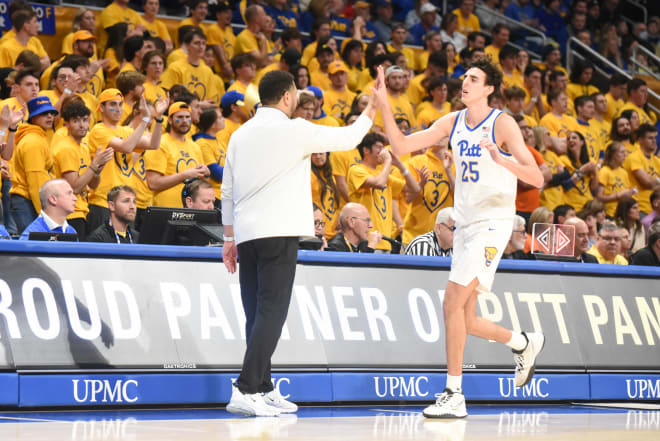
TWO QUESTIONS WE HAVE
How many spots does Capel have to fill?
In last week’s column, I predicted that Pitt hoops might not lose any additional transfers beyond John Hugley.
That prediction held for about four days or so, because Nate Santos went into the portal on Tuesday.
So much for that.
I actually left the door open for Santos to potentially join Hugley. I said he was the one guy who was still somewhat up in the air, and that his decision could come down to which players Pitt adds from the portal.
Pitt hasn’t gotten anybody from the portal yet (although they’ve got a Santos-plus player visiting this weekend) but Santos apparently evaluated the situation and decided to look for another opportunity.
I can’t say I blame him. Santos showed some promise this season, I thought. His reputation as a shooter was never really borne out, but he did some things that opened my eyes, primarily on defense, in his work on the glass and his general physicality. I thought we caught some glimpses of the player he could be - especially if his shot started falling - but ultimately, there just wasn’t a lot of room for him in the rotation, even one as thin as Pitt’s was last season.
So Santos is off for greener pastures, and we wish him the best.
Where does that leave Pitt?
By my count, Jeff Capel and company will have four open scholarships to work with this offseason. They’ve got six players coming back with Blake Hinson, Dior Johnson, Will Jeffress, Federiko Federiko and Guillermo and Jorge Diaz Graham. And they’ve got three freshmen coming in Jaland Lowe, Carlton Carrington and Marlon Barnes.
That’s nine. The NCAA says you can have 13. If we’re solving to find the number of open spots, the equation would look like this:
13-9
But I digress, because you can do the math. It’s four. Pitt has four open spots to work with.
So what’s a guy to do with four open scholarship spots?
I’ve said a few times what I think the priorities are/should be. I think a shooter has to be Priority No. 1. Get another Greg Elliott, or someone who can shoot like him (if he could defend like Nike Sibande, that would be a real bonus). The incoming freshmen can shoot, but someone who has done it in college for a few years would be really ideal.
And I think another veteran guard would be valuable. Jaland Lowe is the point guard of the future, but if Pitt could get a one-year fill-in at that spot to work with Lowe, I think it would be good for this year and beyond.
Fill those two spots and you’re off to a good start. Add a wing like Zack Austin from High Point, who is visiting right now, and I think you’ve got a pretty strong rotation. And then you’ve got room to add one more, either from the transfer portal or late-blooming high school prospects.
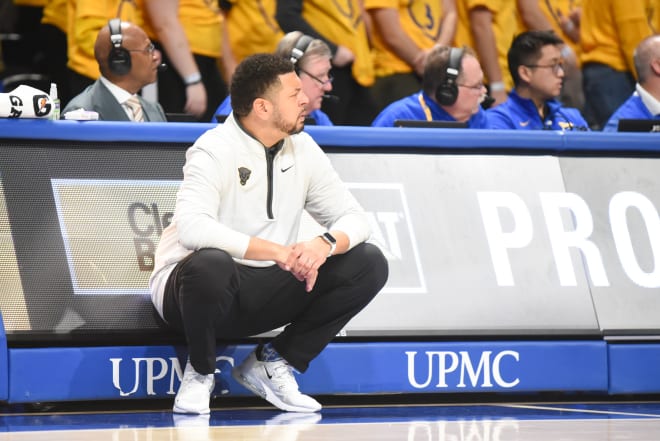
What would the rotation look like?
Let’s talk a little more about the potential hoops rotation.
Let’s assume that Pitt gets some of the priority target positions I mentioned above - a shooter, another guard and a wing - and leave those other two scholarship spots open, at least for the purposes of this discussion.
That would give Pitt at least two point guards (Lowe, possibly Johnson and maybe a transfer); a bunch of off-ball wings (Carrington, Barnes, a transfer shooter and a transfer wing) and five forwards (Hinson, Jeffress, Federiko and Diaz Graham x 2).
Obviously, the Panthers won’t go 12-deep in their rotation, although in a certain sense, they did go to 11 last year after Hugley, Jeffress and Johnson became unavailable. But let’s assume that those unfortunate circumstances don’t befall this coming season’s team and they’re able to largely keep the core intact.
There are a few obvious guys I think are locks to be in the rotation. Hinson, Federiko and the Diaz Graham twins seem like sure things. And the transfers, of course; they would be brought in to fill key roles, so they’re in it. We can count Johnson, too. That’s seven or eight.
I don’t think the coaches will be able to keep Lowe and/or Carrington off the court, that pushes it to nine or 10. And I’m pretty sure Jeffress will have a role.
So now we’re pretty much at 11. Can Pitt really go 11-deep and actually get meaningful minutes for that many guys?
I think the jam-up happens around the 3 and 4 positions. There’s an ongoing debate about whether Hinson can play small forward; my take is that it would be less than ideal to move him there, because I think it sacrifices some of the matchup advantages he created at the 4.
But that’s just me. Maybe the coaches can find favorable matchups for Hinson at the 3, where he would be playing against guys like Nike Sibande. If that move was made, it could open some minutes for a transfer power forward or Jeffress at the 4.
There’s also something to be said for the fact that the 3 and the 4 are somewhat interchangeable with the way Pitt plays. So if the Panthers landed someone like Zack Austin, he could conceivably play on the court with Hinson, and the distinction of which guy is technically at which position - 3 or 4 - would be moot, at best. The biggest distinction would be which opposing player each guy is guarding, and that would be decided on a situational basis.
Personally, I would have Federiko and Guillermo Diaz Graham at center, Hinson and Jorge Diaz Graham at power forward.
Then I would use Lowe and Johnson or a transfer at the one, rotate Carrington and the transfer shooter at the 2 and mix Jeffress, a transfer wing and maybe another guard for a three-guard look at the 3 as well.
That’s pretty much an 11-deep rotation which, again, I don’t think is likely, simply based on precedent. But the bodies - and the skill sets - are there, pending the additions of several transfers in the backcourt and on the wing.
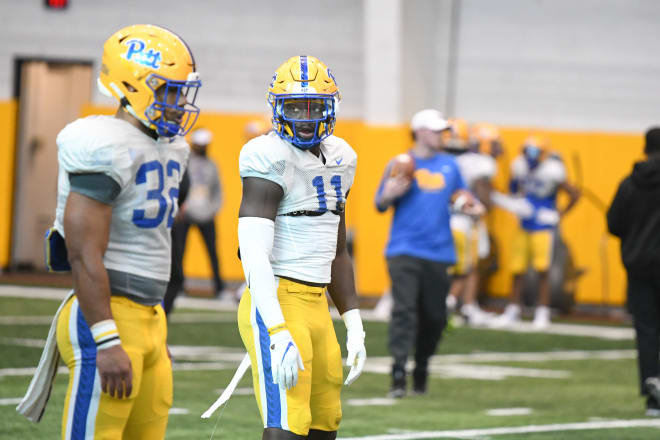
ONE PREDICTION
The stat-stuffer
Every year in late July or early August, I start cramming for fantasy football. That means reading everything I can find and listening to podcasts when I’m not in position to read. I often find myself listening to the Fantasy Footballers podcast, and they have an annual episode where each host announces the three players he’s desperate to have his team that year. They’re the guys each host is highest on, and the theme of the episode is called “My Guys.”
When it comes to covering Pitt football, I’ll admit to having My Guys, too. Sometimes I get them wrong. Michael Smith and Khalil Anderson come to mind; I really went to bat for them. And sometimes I get them right. I was over the top in my praise of Jordan Addison and I continued to bang the drum for Israel Abanikanda after his sophomore season.
Regular readers of this site and regular listeners to the podcast can probably tell you who My Guys have been in the past. And I would say most are aware that I was really, really high on Bangally Kamara last season.
Coming out of training camp, I was going so far as to make all-conference predictions for him. That didn’t come to pass, of course. He had a pretty good season in his first year as a starter, finishing fifth on the team in tackles with 49 and recording three tackles for loss, one sack, one interception, seven pass breakups and 25 quarterback pressures, according to Pro Football Focus. He played what was probably his best game in the Sun Bowl and has been getting a lot of praise this spring.
So I’m doubling down on Kamara for 2023, and I’m predicting this:
I think he improves on every single one of those stats this season. I think he gets more than 49 tackles. I think he gets more than three tackles for loss. I think he gets more than one sack. I think he gets more than one interception. I think he breaks up more than seven passes. And I think he records more than 25 quarterback pressures.
Basically, I think he stuffs the stat sheet as one of Pitt’s top impact players on defense. Maybe the top impact player on defense.
I’ll be as blunt as possible: I think Kamara is an NFL player with the size and athleticism to make an impact at the next level. When you see him in person, he fits the mold perfectly, and when he has played well, he has shown the potential to be the most dominant player on the field.
He just has to do it more consistently.
Pat Narduzzi said as much this week when he talked about how he could “feel” Kamara more than any other linebacker at the team’s most recent scrimmage, but that further review of the scrimmage film - after he watched the tape, you might say - he saw a lot of small details that need to be cleaned up.
Part of that is Narduzzi’s natural inclination toward seeking perfection. But I think part of it is also his belief that Kamara can be a big-time playmaker, so he’s going to keep pushing him to get every detail right because he knows that the sky is the limit.
I don’t know if Kamara will reach the sky in 2023, but I think he’ll get pretty damn close.
